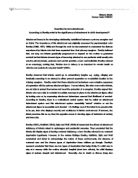"Cross cultural research has demonstrated many similarities in infant attachment styles across different cultures" - To what extent are there cross cultural variations in attachment?
Huckleberry Briscoe Psychology 08/05/2007 8:07 AM
“Cross cultural research has demonstrated many similarities in infant attachment styles across different cultures”
To what extent are there cross cultural variations in attachment?
The Strange Situation test lasts for approximately 20 minutes and was used on American infants aged between 12 and 18 months. It takes place in the laboratory and the method used is controlled observation. The Strange Situation consists of 7 episodes, which involve the infant being separated from his or her caregiver, being with a stranger, and reunion with the caregiver. There are two separations and reunions. Separation protest, the infant’s willingness to explore, stranger anxiety, and reaction to reunion with the caregiver are the key behaviours used to assess the security/insecurity of the attachment relationship.
The Strange Situation demonstrated considerable individual differences in secure and insecure attachment types. Most of the infants displayed behaviour categorized as typical of secure attachment 70% (type B), with 15% anxious/resistant (type C) and 15% anxious/avoidant (type A).
The securely attached infants were distressed when separated from the caregiver, and sought contact and soothing on reunion. Anxious/resistant attachment was characterized by ambivalence and inconsistency, as the infants were very distressed at separation but resisted the caregiver on reunion. Anxious/avoidant attachment was characterized by detachment as the infants did not seek contact with the caregiver and showed little distress at separation. The Strange Situation was created and tested in the USA, which means that it may be culturally biased as it will reflect the norms and values of American culture. The Strange Situation test assumes that behaviour has the same meaning in all cultures, when in fact social constructions of behaviour differ greatly. Thus, the usefulness of the Strange Situation in assessing attachment across cultures may be limited by the subjectivity inherent in observation and interpretation of behaviour. This lack of being able to generalize means that the ecological validity of the Strange Situation must be questioned.







